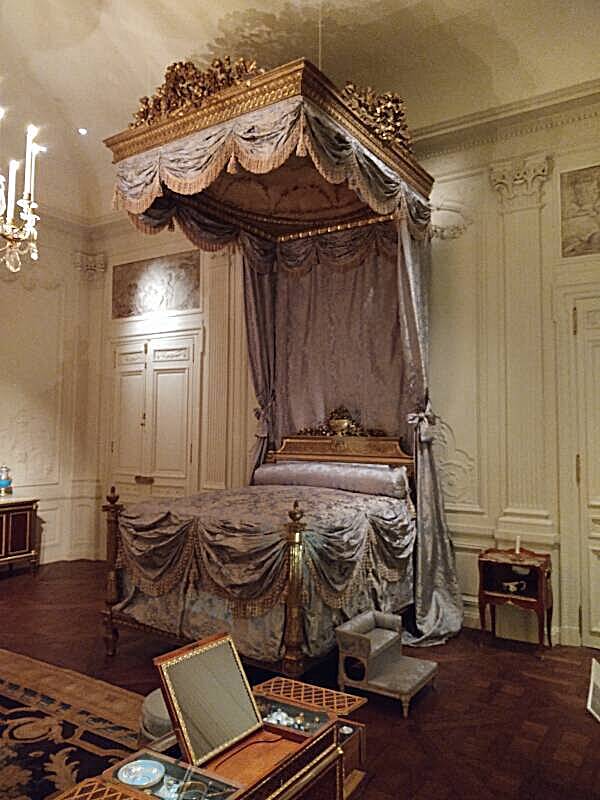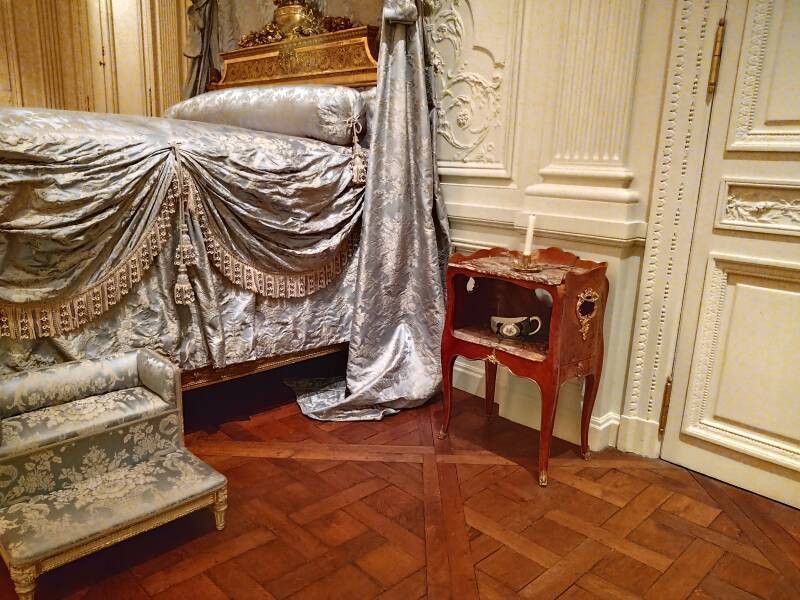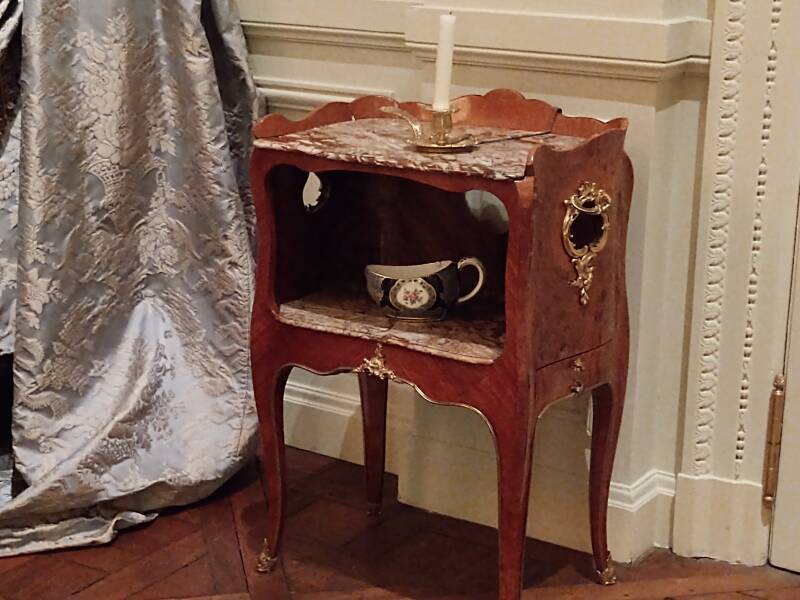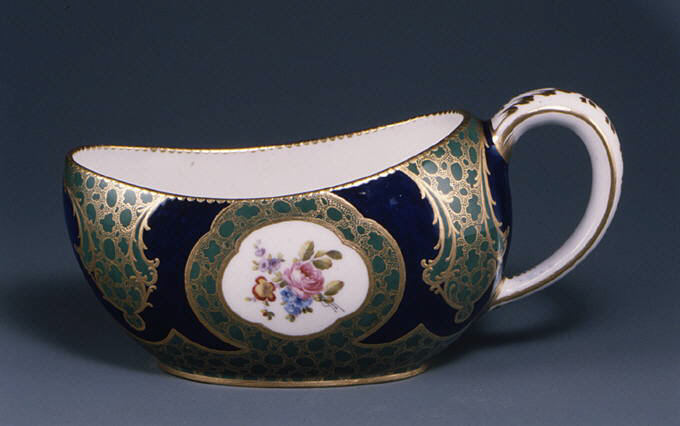
French Chamber Pots of the 1750s
Chamber Pots
A chamber pot is exactly what its name suggests — a pot that you keep in your chamber or bed room. It's there to be used as a toilet overnight, saving you from the bother of going outdoors. In the morning you empty the pot, rinse it out if possible, and return it to the room. Chamber pots have been used at least since the 6th century BC in Greece, known there and then under a variety of names: αμίς, ουράνη, ουρητρίς, σκωραμίς, and χερνίβιον.
The same basic technology was used across Europe through the following two millennia and more. The flush toilet was re-invented in England in the 1590s, but then most people had to wait for almost another three centuries for the widespread manufacture of affordable flush toilets in the late 1800s. During early modern times in Europe, walking along the streets in the morning was hazardous as people dumped chamber pot contents out of upstairs windows. Spanish explorers from the 1500s onward were amazed when they arrived in the Americas and found enormous cities with highly effective waste disposal systems. Streets back in Europe were open sewers. The European explorers grabbed all the gold and silver they could find and mostly ignored the sanitary technology.

Hôtel Lauzun is at 17 Quai d'Anjou on Île Saint-Louis, one of the two islands in the Seine on which Paris was first founded. As its name suggests, Île de la Cité, the larger island just downstream, was home to the original settlement.
French Pre-Revolutionary Chamber Pots
The Metropolitan Museum of Art in New York City has some period rooms, each with a set of furniture, other furnishings, and wall panels and ceilings removed from large homes of the European upper class. One of these is the Lauzun Room, taken from the Hôtel Lauzun in Paris, at 17 quai d'Anjou on the Île Saint-Louis.

Yes, that's a chamber pot in the small cabinet next to the bed. As we'll see, the chamber pot dates from 1757–1758.
Hospes, Hospitis, Hostel, Hôtel, Hôtel Peculier
The English word hotel is derived from the French hôtel, which comes from the same origin as hôpital and thus English hospital. The early modern French concept of hôtel was a building that provided care for its frequent visitors, possibly providing medical care but possibly a literal town-house. That is, a private place of temporary lodging in the city owned by a nobleman whose main dwelling was a château, a large castle-like fortified house in the country.
In today's French language, hôtel has the same meaning as the English term. The French now use hôtel particulier for the old meaning, with some place names preserving the old term with the old meaning. For example, Hôtel-Dieu (or "Hostel of God") in Paris has been the site of a hospital since the Middle Ages, and Hôtel-Dieu was the standard name for the main medical care facility in any city. Or the Hôtel des Invalides in Paris, which retains its meaning of a hospice for war wounded. Also, an hôtel de ville is a town hall, an alternative to the smaller mairie or mayor's office.
The early modern French hôtel came from the Old French hostel, which in turn came from the Latin hospes or hospitis, meaning a stranger or foreigner, and thus a guest. The French nobleman's hôtel might have a permanent staff. When the master stayed there during a visit to the city, he and his party would be treated as occasional guests.
In medieval London, inn was used to describe this concept. The Earl of Northumberland, like most wealthy noblemen of England, owned a large structure in the City of London where he stayed while visiting. It was known as "Northumberland's Inn" during medieval times. It came to be called "Northumberland House" when the English word inn had changed to mean a business renting rooms to visitors. In today's English, inn and hotel both refer to businesses renting rooms. An inn will generally be a much smaller operation, typically a small fraction the size of a hotel.
It gets more confusing when a building was built as what the French now call a hôtel particulier and has been converted to a modern hôtel, as is the case for the Hôtel de Crillon on the Place de la Concorde in Paris.
Hôtel de Lauzun
The building was completed in 1657, changing hands several times but remaining a home of nobility until the French revolution. The Metropolitan's description of the room says:
The Lauzun Room
Acquired in the late nineteenth century by Baron Frédéric-Jérôme Pichon (1812—1896), the original provenance of this oak paneling is not known. The baron, a well-known Parisian bibliophile and collector, incorporated the paneling, stripped of its original paint, into the large library that he installed on the first floor of the Paris residence, the Hôtel Lauzun, at 17 quai d'Anjou, on the Île Saint-Louis. Dating from about 1770, the panelings was not in keeping with the seventeenth-century décor of the Hôtel Lauzun and was dismantled and sold in about 1906.
The three grisaille overdoor paintings in the style of Piat-Joseph Sauvage (1744—1818), the Carrara marble chimneypiece, and its framed overmantel mirror are contemporary with, but not original to, the room. Lacking evidence of the original paint color and finish, a glue-based distemper was chosen for the woodwork in this room in accordance with eighteenth-century techniques.
French, ca. 1770
Purchase.
Mr. and Mrs. Charles Wrightsman Gift, 1976 (1976 91.1, .2)
Let's look closer at the small cabinet next to the bed and the chamber pot it holds.

Bedside Table.
Oak, tulipwood, kingwood; gilt bronze, Sarrancolin marble.
Attributed to Bernard Van Risenburgh II
(after 1696—ca. 1768).
Stamped with the crowned BV mark for the
château de Bellevue.
Very likely one of two night tables acquired by
Madame de Pompadour, mistress of Louis XV,
from the marchand mercier, or luxury dealer,
Lazare Duvaux for the Château de Bellevue
in 1750 and 1756.
French, 1750—56.
Gift of Mr. and Mrs. Charles Wrightsman,
1985 (1985.313.I)
Chamber Pot.
Soft-paste porcelain.
French (Sèvres), 1757—58
Bequest of R. Thornton Wilson, in memory of his wife,
Florence Ellsworth Wilson, 1977 (1977.216.46)
The Metropolitan's description of the chamber pot describes its provenance and has some associated essays from their art history collection. Here's the museum's public-domain image of the chamber pot:

Sèvres Porcelain
Sèvres is now a southwestern suburb of Paris, within the Hauts-de-Seine département in the Île-de-France region surrounding the capital city. It's just 10 kilometers from Kilomètre Zéro at the center of Paris to Sèvres. The Manufacture nationale de Sèvres is one of Europe's main porcelain producers. It was founded in Vincennes in 1738 under the support of King Louis XV and Madame de Pompadour, who probably once owned the table shown above. The primary manufacturing operation was moved to Sèvres in 1756. It has been tied closely to the national government all along — royal, imperial, now national.
Soft-paste porcelain was developed by European pottery makers attempting to duplicate the Chinese porcelain that began arriving in Europe before the 14th century. The Medici porcelain developed in 1575 was the first successful approximation, using white clay containing feldspar powder, calcium phosphate, CaSiO3 or wollastonite, and quartz. Early French soft-paste porcelain Française was produced in 1673 in Rouen. More successful later formulations were based on kaolin, quartz, feldspar, nepheline syenite, and other feldspathic minerals. These soft-paste formulations are fired at around 1200–1250°C. The more easily formed hard-paste porcelain is fired at higher temperatures around 1400°C and had been developed in China around the 7th to 8th century. It was only re-developed in Europe in the early 1700s.
The soft-paste formulation developed at Vincennes and Sèvres had fewer imperfections than its competitors, yielding a more uniform white material. The quality made the Sèvres factory the leading porcelain manufacturer in all of Europe.
So, the residents of the Hôtel de Lauzun didn't have a raised commode seat toilet, a much later invention that would also be made of porcelain. They just had a pot.
But at least it was a nice pot.
Château Bellevue
Agnès Sorel,Royal Mistress
of Charles VII
of France
Jeanne Antoinette Poisson, the Marquise de Pompadour and also known as Madame de Pompadour, was the maîtresse-en-titre or official chief mistress of King Louis XV from 1745 to 1751. Yes, "official chief mistress" was a position within the French court from the reign of Charles VII (ruled 1422-1461) through Louis XV (ruled 1710-1774). Louis may have discredited the absolute monarchy and weakened the treasury, leading to the French Revolution 15 years after his death, but it was nothing new for the French king to have an official chief mistress.
She met the King at a royal masked ball at the Palace of Versailles in February 1745. By the next month she was the King's mistress, living at Versailles in an apartment directly above his. Two months after that, in May, and surely to no one's surprise, the official separation between her and her husband was announced. She remained close to the King after 1751, a friend and confidant until her death in 1764.
You had to have a title to be presented at court, so the King gave her the marquisate of Pompadour, including the estate, the coat-of-arms, and the title of Marquise. Pompadour is a town about half-way from Paris to the Spanish border, in the Aquitaine-Limousin-Poitou-Charentes region. In the early 1700s the estate, coat-of-arms, and title had been transferred to the King.
| European royal, noble, and chivalric ranks |
| Emperor / Empress |
| King / Queen |
| Archduke / Archduchess |
| Grand Duke / Grand Duchess Grand Prince / Grand Princess |
| Prince / Princess |
| Duke / Duchess |
| Sovereign Prince / Princess |
| Marquis / Marquise |
| Count / Countess Earl |
| Viscount / Viscountess Vidame |
| Baron / Baroness |
| Hereditary Knight |
| Knight |
| Gentleman / Lady |
Louis bought land in Meudon, adjacent to Sèvres southwest of Paris. The estate was named the Château Bellevue as a reference to its wonderful views from its plateau down over the Seine. Louis gave her the land in 1749, and the château was finished by 1750.
The bedside table seen above was probably one of two she bought to furnish the estate. It was abandoned and looted during the revolution, and demolished in 1823.
History of Hôtel de Lauzun
Charles Gruyn des Bordes was the son of an inn-keeper (as if this confusion about hôtel versus hôtel wasn't bad enough already). He grew wealthy from the inn trade, gained influence, and became general commissioner of cavalry during a time of civil disorder. That position allowed him to become much more wealthy through financial speculation, to the point he was known as a "financier" rather than just a mere inn-keeper or general commissioner of cavalry.
He purchased the lot on the Île Saint-Louis in 1641. By the 1650s he had married Geneviève de Mony, who is said to have accelerated the completion of the house. It isn't clear to me whether that was because she funded the project, or because she pressured the prominent architect, Louis Le Vau. The house was completed in 1657. The opulent decoration reflected the competition with the nearby Hôtel Lambert de Thorigny.
Gruyn de Bordes got mixed up in some shady business deals. An inquest was held. He was found guilty of fraud, put into prison, and died there. His wife had maintained separate accounts for everything. Geneviève de Mony had kept her financial affairs intact and left the hôtel to her son.
Meanwhile, Antoine Nompar de Caumont, the Duc de Lauzun, had fallen out of favor with Louis XIV and had spent a decade in prison. He had somehow managed to covertly marry his lover during this time, and she ransomed him from the King's imprisonment.
Sprung from prison, the Duc de Lauzun immediately purchased the building from the son of Geneviève de Mony and set about further upgrading the decorations.
Amazon
ASIN: B000G6BLRE
Recall that in the final segment of History of the World, Part I, Harvey Korman portrayed Count de Mony while Mel Brooks was Jacques, le garçon de pisse, the lackey who handled the chamber pot for the gathered royalty and nobility.
The hôtel changed hands, being owned by the Marquis de Richelieu, then Pierre-François Ogier the receveur du clergé, and then by the Marquis de Pimôdan,
So, while the hôtel was occupied by a series of nobility — Dukes, Duchesses, Barons, whatever the plural of Marquis would be — they didn't have indoor sanitary plumbing. Until the late 1800s and the large-scale manufacturing of John Harrington's 1590s re-invention of the flush toilet, no one in Europe had such a thing.
Baudelaire'sHôtel
Meanwhile, through the 1700s, the new districts to the west of Paris became fashionable while the Île Saint-Louis became first declassé and then almost a backwater. And then, the French Revolution, a bad time to be nobility. The upstairs was divided up and converted into apartments where successful artisans and craftsmen lived.
By the 1840s it was known as the Hôtel Pimodan and was owned by Baron Jérôme Pichon, auditeur au Conseil d'État and owner of some of the furnishings displayed at the Metropolitan Museum of Art. In 1843 the Baron rented the upstairs apartments to the writer Charles Baudelaire and the physician and writer Théophile Gautier. They seemed like nice, quiet gentlemen.
The two formed their Club des Hashischins and experimented with hashish along with Victor Hugo, Alexandre Dumas, Gérard de Nerval, Honoré de Balzac, Eugène Delacroix, and other literary and artistic figures. They consumed their hashish dissolved in strong coffee which the members described as looking like a greenish preserve.
All this was going on in the rented rooms upstairs while the owner lived below with the library paneling now in the museum.
Gautier wrote about the club in an article "Le Club des Hashischins" in the February 1846 issue of the Revue des Deux Mondes. Baudelaire wrote the first poems of Les Fleurs du Mal while living there.
Amazon
ASIN: 0486270920
Amazon
ASIN: 0879234628
Baudelaire also smoked opium, consumed laudanum (a tincture of opium dissolved in alcohol), and drank alcohol in excess, the combination of which led to his death. Opiates cause constipation, so all the opium smoking and laudanum drinking would have turned Baudelaire's bowel movements into infrequent gravel, greatly reducing his need to empty and clean the chamber pot. So at least he had that going for him.